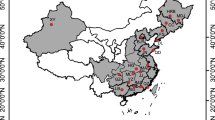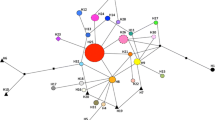Abstract
Genetic comparisons between native and invasive populations of a species can provide insights into its invasion history information, which is useful for guiding management and control strategies. The coral berry Ardisia crenata was introduced to Florida last century as a cultivated ornament plant, and has since spread widely throughout the southern regions of the USA. Previously, the genetic variation among 20 natural populations of A. crenata across its distribution center in southern China was quantified using seven microsatellite markers. Here we expand on that work by additionally sampling individuals from four other native populations in Taiwan and Japan, and from five invasive populations in the USA. We also examined the results from one chloroplast intergenic spacer region (trnF-trnL) in all 29 populations. Our aim is to identify the invasion source and subsequent history of the species’ spread throughout the southern USA. We observed lower genetic diversity in the invasive populations based on both microsatellite and chloroplast markers. Our data show that the invasive populations can be clustered with native populations in southeastern China, inferring this region as the geographic origin of A. crenata cultivars invading the USA. We further classified invasive individuals into invasive I and invasive II clusters. Nantou in Taiwan and Xihu in mainland China are the most closely related populations to those, which identify the former as potential sources for host-specific control agents. Our results, combined with the known introduction records, suggest that A. crenata was first multiply introduced into Florida and then secondarily colonized Louisiana and Texas from Florida.



Similar content being viewed by others
References
Bailey LH (1922) The standard encyclopedia of horticulture, vol 1. McMillan, New York
Bock DG, Zhan A, Lejeusne C, MacIsaac HJ, Cristescu ME (2011) Looking at both sides of the invasion: patterns of colonization in the violet tunicate Botrylloides violaceus. Mol Ecol 20:503–516
Bray SR, Kitajima K, Sylvia DM (2003) Mycorrhizae differentially alter growth, physiology, and competitive ability of an invasive shrub. Ecol Appl 13:565–574
Chapuis M, Estoup A (2007) Microsatellite null alleles and estimation of population differentiation. Mol Biol Evol 24:621–631
Chen J (1979) Flora of China, vol 58. Science Press, Beijing, pp 69–70
Cheon CP, Chung MY, Chung MG (2000) Allozyme and clonal diversity in Korean populations of Ardisia japonica and Ardisia crenata (Myrsinaceae). Isr J Plant Sci 48:239–245
Conover CA, Poole RT (1989) Production and use of Ardisia crenata as a potted foliage plant. Foliage Digest 12:1–3
Crawford NG (2010) SMOGD: software for the measurement of genetic diversity. Mol Ecol Res 10:556–557
Dehnen-Schmutz K, Touza J, Perrings C, Williamson M (2007) A century of the ornamental plant trade and its impact on invasion success. Divers Distrib 13:527–534
DeWalt SJ, Hamrick JL (2004) Genetic variation of introduced Hawaiian and native Costa Rican populations of an invasive tropical shrub, Clidemia hirta (Melastomataceae). Am J Bot 91:1155–1163
Dozier H (1999) Plant introductions and invasion: history, public awareness, at the case of Ardisia crenata. Dissertation, University of Florida, Florida
Evanno G, Regnaut S, Goudet J (2005) Detecting the number of clusters of individuals using the software STRUCTURE: a simulation study. Mol Ecol 14:2611–2620
Excoffier L, Laval G, Schneider S (2005) Arlequin (version 3.0): an integrated software package for population genetics data analysis. Evol Bioinform Online 1:47–50
Falush D, Stephens M, Pritchard JK (2003) Inference of population structure using multilocus genotype data: linked loci and correlated allele frequencies. Genetics 164:1567–1587
Gao H, Williamson S, Bustamante CD (2007) A Markov chain Monte Carlo approach for joint inference of population structure and inbreeding rates from multilocus genotype data. Genetics 176:1635–1651
Genton BJ, Shykoff JA, Giraud T (2005) High genetic diversity in French invasive populations of common ragweed, Ambrosia artemisiifolia, as a result of multiple sources of introduction. Mol Ecol 14:4275–4285
Goolsby JA, De Barro PJ, Makinson JR, Pemberton RW, Hartley DM, Frohlich DR (2006) Matching the origin of an invasive weed for selection of a herbivore haplotype for a biological control programme. Mol Ecol 15:287–297
Goudet J (2001) FSTAT, a program to estimate and test gene diversities and fixation indices (version 2.9.3). http://www.unil.ch/izea/softwares/fstat.html
Hall TA (1999) BioEdit: a user-friendly biological sequence alignment editor and analysis program for Windows 95/98/NT. Nucl Acids Symp Ser 14:95–98
Hamrick JL, Godt MJW (1996) Effects of life history traits on genetic diversity in plant species. Philos T Roy Soc B 351:1291–1298
Heller R, Siegismund HR (2009) Relationship between three measures of genetic differentiation G ST, D EST and G′ST: how wrong have we been? Mol Ecol 18:2080–2083
Hong L, Niu HG, Shen H, Ye WH, Cao HL (2008) Isolation and characterization of polymorphic microsatellite loci in Ardisia crenata (Myrsinaceae). Conserv Genet 9:491–494
Jakobsson M, Rosenberg NA (2007) CLUMPP: a cluster matching and permutation program for dealing with label switching and multimodality in analysis of population structure. Bioinformatics 23:1801–1806
Jost L (2008) GST and its relatives do not measure differentiation. Mol Ecol 17:4015–4026
Jost L (2009) D vs. G ST: response to Heller and Siegismund (2009) and Ryman and Leimar (2009). Mol Ecol 18:2088–2091
Kitajima K, Fox AM, Sato T, Nagamatsu D (2006) Cultivar selection prior to introduction may increase invasiveness: evidence from Ardisia crenata. Bio Invasions 8:1471–1482
Langeland KA, Burks KC (1998) Identification and biology of non-native plants in Florida’s natural areas, 2nd edn. University of Florida, Florida, pp 100–101
Lavergne S, Molofsky J (2007) Increased genetic variation and evolutionary potential drive the success of an invasive grass. Proc Natl Acad Sci USA 104:3883–3888
Lee AK, Suh JK, Roh MS, Slovin JP (2003) Analysis of genetic relationships of Ardisia spp. using RAPD markers. J Hortic Sci Biotech 78:24–28
Maron JL, Vila M, Bommarco R, Elmendorf S, Beardsley P (2004) Rapid evolution of an invasive plant. Ecol Monogr 74:261–280
Marrs RA, Sforza R, Hufbauer RA (2008) When invasion increases population genetic structure: a study with Centaurea diffusa. Bio Invasions 10:561–572
McCauley DE, Smith RA, Lisenby JD, Hsieh C (2003) The hierarchical spatial distribution of chloroplast DNA polymorphism across the introduced range of Silene vulgaris. Mol Ecol 12:3227–3235
Meimberg H, Hammond JI, Jorgensen CM, Park TW, Gerlach JD, Rice KJ, McKay JK (2006) Molecular evidence for an extreme genetic bottleneck during introduction of an invading grass to California. Bio Invasions 8:1355–1366
Mu HP, Hong L, Cao HL, Wang ZF, Li ZC, Shen H, Wang ZM, Ye WH (2010) Genetic variation of Ardisia crenata in south China revealed by nuclear microsatellite. J Syst Evol 48:279–285
Novak SJ, Mack RN (2005) Genetic bottlenecks in alien plant species: influence of mating systems and introduction dynamics. In: Sax DF, Stachowicz JJ, Gaines SD (eds) Species invasions: insights into ecology, evolution and biogeography. Sinauer, MA, pp 201–228
Nybom H (2004) Comparison of different nuclear DNA markers for estimating intraspecific genetic diversity in plants. Mol Ecol 13:1143–1155
Okada M, Lyle M, Jasieniuk M (2009) Inferring the introduction history of the invasive apomictic grass Cortaderia jubata using microsatellite markers. Divers Distrib 15:148–157
Pascarella JB (1997) Breeding systems of Ardisia Sw (Myrsinaceae). Brittonia 49:45–53
Peakall R, Smouse PE (2006) GENALEX 6: genetic analysis in Excel. Population genetic software for teaching and research. Mol Ecol Notes 6:288–295
Piry S, Alapetite A, Cornuet JM, Paetkau D, Baudouin L, Estoup A (2004) GENECLASS2: a software for genetic assignment and first-generation migrant detection. J Hered 95:536–539
Powell W, Machray GC, Provan J (1996) Polymorphism revealed by simple sequence repeats. Trends Plant Sci 1:215–222
Pritchard JK, Stephens M, Donnelly P (2000) Inference of population structure using multilocus genotype data. Genetics 155:945–959
Rannala B, Mountain JL (1997) Detecting immigration by using multilocus genotypes. Proc Natl Acad Sci USA 94:9197–9201
Raymond M, Rousset F (1995) GENEPOP (version 1.2): population genetics software for exact tests and ecumenicism. J Hered 86:248–249
Roh MS, Lee AK, Suh JK, Slovin J (2006) Confirmation of cross-pollination of Ardisia crenata by sequence-characterized amplified region (SCAR) markers (Hudson) Beauv. in North America. Sci Hortic-Amsterdam 109:361–367
Rosenthal DM, Ramakrishnan AP, Cruzan MB (2008) Evidence for multiple sources of invasion and intraspecific hybridization in Brachypodium sylvaticum (Hudson) Beauv. in North America. Mol Ecol 17:4657–4669
Sakai AK, Allendorf FW, Holt JS, Lodge DM, Molofsky J, With KA, Baughman S, Cabin RJ, Cohen JE, Ellstrand NC, McCauley DE, O’Neil P, Parker IM, Thompson JN, Weller SG (2001) The population biology of invasive species. Annu Rev Ecol Syst 32:305–332
Selkoe KA, Toonen RJ (2006) Microsatellites for ecologists: a practical guide to using and evaluating microsatellite markers. Ecol Lett 9:615–629
Singhurst JR, Ledbetter WJ, Holmes WC (1997) Ardisia crenata (Myrsinaceae): new to Texas. Southwest Nat 42:503–504
Sun JH, Li ZC, Jewett DK, Britton KO, Ye WH, Ge XJ (2005) Genetic diversity of Pueraria lobata (kudzu) and closely related taxa as revealed by inter-simple sequence repeat analysis. Weed Res 45:255–260
Thompson JD, Gibson TJ, Plewniak F, Jeanmougin F, Higgins DG (1997) The CLUSTAL_X windows interface: flexible strategies for multiple sequence alignment aided by quality analysis tools. Nucleic Acids Res 25:4876–4882
Van Driesche RG, Bellows TS (1996) Biological control. Chapman & Hall, New York
Ward SM, Gaskin JF, Wilson LM (2008) Ecological genetics of plant invasion: what do we know? Invasive Plant Sci Manag 1:98–109
Weir BS (1996) Genetic data analysis II. Sinauer Associates, Sunderland
Williams DA, Overholt WA, Cuda JP, Hughes CR (2005) Chloroplast and microsatellite DNA diversities reveal the introduction history of Brazilian peppertree (Schinus terebinthifolius) in Florida. Mol Ecol 14:3643–3656
Wunderlin RP (1982) Guide to the vascular plants of central Florida. University Presses of Florida, Tampa, p 472
Acknowledgments
We thank L-F. Wu, E. Siemann, G. Cellis and K. Kitajima for collecting leaf materials. This research was funded by National Natural Science Foundation of China (30530160), National Basic Research Program of China (973 Program, 2009CB119200), and the Natural Science Foundation of Guangdong Province, China (05200701).
Author information
Authors and Affiliations
Corresponding author
About this article
Cite this article
Niu, HY., Hong, L., Wang, ZF. et al. Inferring the invasion history of coral berry Ardisia crenata from China to the USA using molecular markers. Ecol Res 27, 809–818 (2012). https://doi.org/10.1007/s11284-012-0957-1
Received:
Accepted:
Published:
Issue Date:
DOI: https://doi.org/10.1007/s11284-012-0957-1




